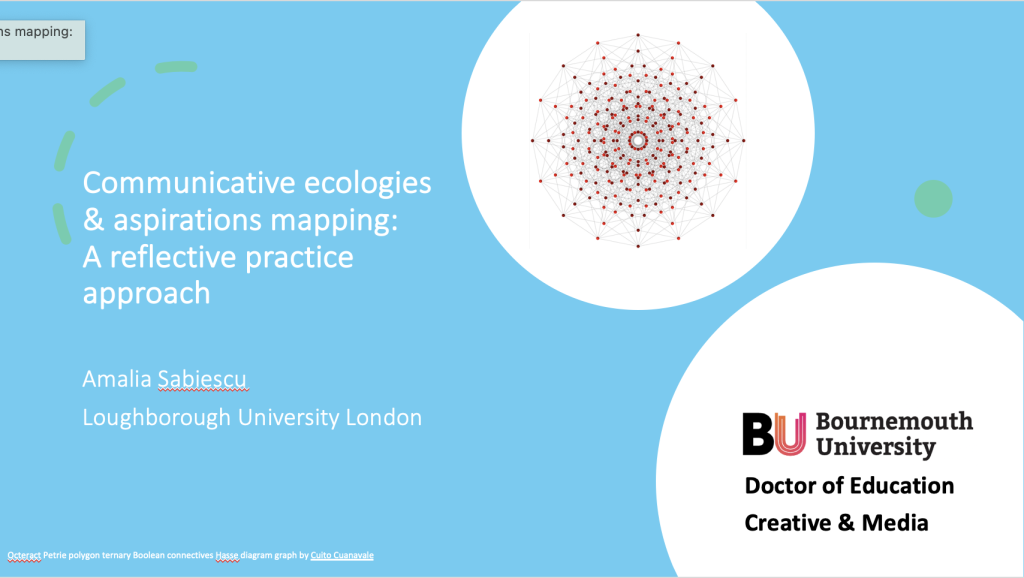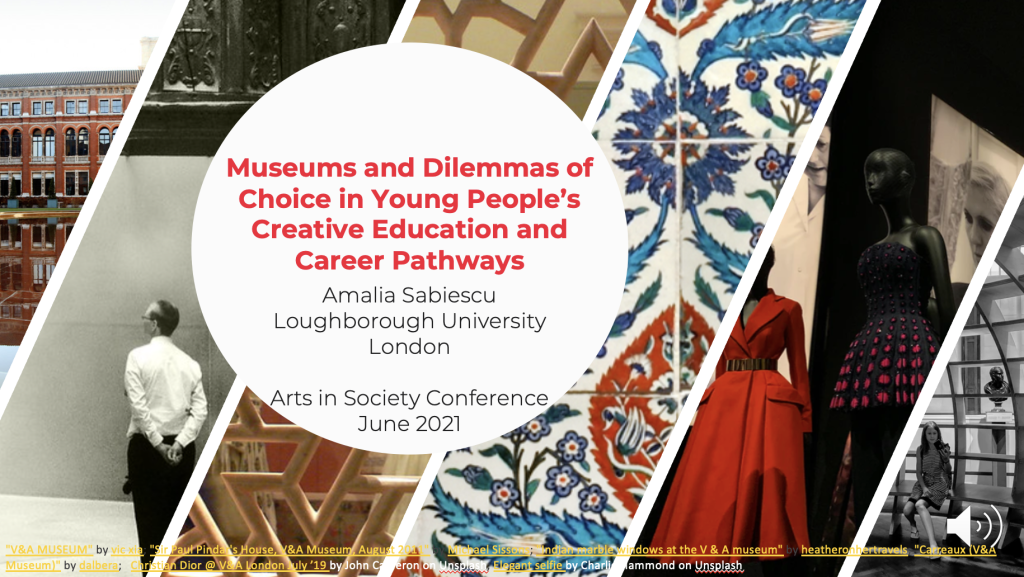Conferences and events
Findings from the Connect2Aspire project have been presented in several conferences and events.
Heritage Assemblages and the Emergence of Youth Participatory Spaces in a British Multicultural City
Paper to be presented in the International Conference Heritages, June 28-30 2023.
This paper employs assemblage theory to trace the contours and the outreach of the culture and heritage ecosystem in a British multicultural city and how it affords (or denies) cultural engagement opportunities for young people. As developed by Gilles Deleuze and Félix Guattari (1988), and most recently by Manuel DeLanda (2006, 2016) assemblage theory aligns to principles of ecological and systems thinking, privileging an investigation approach that accounts for holism, interrelatedness, process and constant change. This perspective has been adopted in critical heritage studies to theorise heritage as entanglements of material, biological and socio-technical components and thus examine hegemonic systems of heritage interpretation, management and governance (e.g., Harrison 2021, 2013; Bennett et al 2017).
The paper draws on an ethnographic study conducted in the multicultural city of Coventry (UK) to explore the role of cultural engagements in informing young people’s aspirations. The data corpus captures the views of official heritage institutions, as well as those of young people and community organisations, particularly from the Roma migrant community, gathered through semi-structured interviews and creative research workshops via participatory photography and communicative ecologies mapping. By applying assemblage theory on this rich data corpus, the paper offers a deep, nuanced analysis of the constitution of volatile cultural engagement spaces and the strategies used to reach out to the diverse youth population of the city. Theoretically, the paper extends previous scholarship on heritage assemblages by tracing the role of official and grassroots culture and heritage organisations in the constitution of youth engagement spaces, interpreted through a dual lens, coming from organisations and young people themselves.
The Expressive and Reflective Value of Participatory Photography in Research with Young People
Conference paper to be presented at the Eighteenth International Conference on the Arts in Society, New Aesthetic Expressions. The Social Role of Art, 5-7 July 2023.
Photography has a long history of being utilised in social science research for its capacity to capture and document material culture and human behaviour (Szto, Furman and Langer 2005; Pauwels 2020). More recent articulations of participatory photography draw on the value of photography as a tool for self-exploration and reflection to shed light on personal histories, experiences and aspirations (Gomez & Vannini 2017). In this paper, we explore the value of participatory photography for engaging young people in deep, reflexive explorations of their aims and aspirations and how these are contextualised in the socio-cultural and economic environments that they were inhabiting. We report on two creative research workshops with distinctive approaches, the first focused on enhancing visual and photography skills as tools for enhanced reflexivity; and the second engaging young people in a custom workshop experience of creating their personal aspirations zines. The two workshops were offered as part of a mixed methods study that looked at the bearing of cultural and interest-based engagements for shaping young people’s aspirations. 285 young from all walks of life have been involved overall, through methods ranging from interviews to surveys and focus groups, creative workshops and analysis of creative artefacts produced by participants. The analysis of rich data corpus enabled us to single out the distinctive role playwd bv creative research approaches in studying rich, complex constructs such as aspirations. In this paper, we offer insights from this analysis focusing on the methodological approach and techniques, and how these served to enhance the expressive potential and reflexivity in young people in ways that are not afforded by traditional data collection methods.
Communicative ecologies and aspirations mapping: A reflective practice approach
Keynote presentation and workshop, Ed D Creative and Media, Bournemouth University, October 6th, 2022, online

Abstract
This two-hour presentation and workshop will take a hands-on and reflective practice approach to explore the dynamics between communication, social interaction and the development of aspirations. The workshop will start by introducing the theoretical underpinnings of this approach, drawing on an assemblage theory perspective on the development of aspirations. This lens allows examining the way information exchanges and interactions in social and communicative assemblages underpin the development of interests, aspirations, as well as over the long term, contributing to building skills, self-confidence and identities in children and young people. The hands-on part of the workshop will draw on communicative ecologies mapping, an established practice in communication for social change research and practice, adapted in this workshop to look at the formation of life and career aspirations. Participants will use a ready-made mapping template on an online collaborative whiteboard, where group work will be interweaved with sharing and reflection.
Museums and Dilemmas of Choice in Young People’s Creative Education and Career Pathways
Online paper presented at the 16th International Conference on the Arts in Society, 15-18 June 2021.

Abstract
The role of museums in informing young people’s creative education and career choices is increasingly recognised. While numerous museums now have dedicated young people’s programmes that include creative education and careers support, there is a gap in knowledge about the profiles, information needs and challenges faced by young people while they attempt to choose, train for and access creative careers. This paper draws on a three-year study on two flagship events offered by the Victoria and Albert Museum’s Young People’s Programme: three editions of a creative careers fair and two editions of a creative education five-day course for young people not in education, employment or training. The study consulted more than 260 young people who attended one of the two events, by means of interviews, questionnaires, focus groups and analysis of creative outputs. Based on this rich dataset, the study found that young people’s information needs differ according to two aspects: decision-making about a creative career and associated education pathways; and creative career stage. On this basis, the paper offers a detailed segmentation of young people that features socio-demographics, career interests and the type of information and support they need to choose, train for and access creative careers. The findings can be taken up by cultural institutions to inform the design of their programmes that address young people, creative education, and creative careers support.
Assemblage theory, communicative assemblages and problematising the notion of ‘borders’ in community communication
Online paper presented at IAMCR 2021, 11-15 July 2021
Download paper (PDF file)
Synopsis
Borders are studied at the interstices of several disciplines – including anthropology, sociology and geography among others, with scholarship cumulated in the interdisciplinary field of research and practice of border studies. Scholarly interest spans borders in their geographical sense (borderlands), but also the social, political and cultural dimensions of borders. The definition and theorisation of borders have important implications for communications research and practice, particularly for the study of culture, community and identity. This paper focuses on social and cultural borders or boundaries and how we may better elucidate the role of communication in defining, breaking and redefining borders. It draws on assemblage theory as conceptualised by Gilles Deleuze and Félix Guattari (1998) and more recently by Manuel DeLanda (2006, 2016). The paper furthers scholarship on assemblage theory by applying it to communication processes. It fleshes out the concept of ‘communicative assemblages’ as assemblages whose primary function is to produce and exchange information, and shows how these play a critical role in defining borders instantiated at various scales, community to individual. These notions are illustrated through empirical research with different Roma minority communities in the UK and Romania conducted between 2010 and 2021.
“The Museum Who Cares”: Tapping into the Art of Relevance for Diversifying Young People Audiences
Online paper presented at the 14th International Conference on the Inclusive Museum, 8-10 September 2021.

Abstract
Young people, particularly if coming from disadvantaged or economically deprived communities, are an audience notoriously difficult to reach out to by museums. Drawing on Nina Simon’s concept of “relevance”, this paper explores how museums can change young people’s perceptions and build relationships by filling a genuine need in their lives. The focus in this paper is on young people who are grappling with difficulties in getting a start on creative careers, and how museums can play a supportive role to fill this gap. The paper presents findings from a research study on two editions of a five-day photography course offered as part of the Victoria and Albert Museum’s Young People’s Programme in 2018 and 2020. The courses addressed young people not in education, employment or training and have been run by the V&A in collaboration with two local charities. Workshop sessions were held alternatively at the V&A in South Kensington and in East London locations. Based on a rich qualitative dataset that gathered the views of 27 young people via focus groups, surveys, observation and analysis of creative outputs, the paper analyses young people’s needs and expectations when joining the workshop, modes of engagement and outcomes, and interprets them through the theoretical lens of ‘relevance’. Findings show how the V&A experience filled a genuine need in young people’s creative career orientation, and in turns how this contributed to changing young people’s perceptions about the V&A, museums and their relevance to their lives and professional pathways.
There was a problem loading the content, please login to refresh.